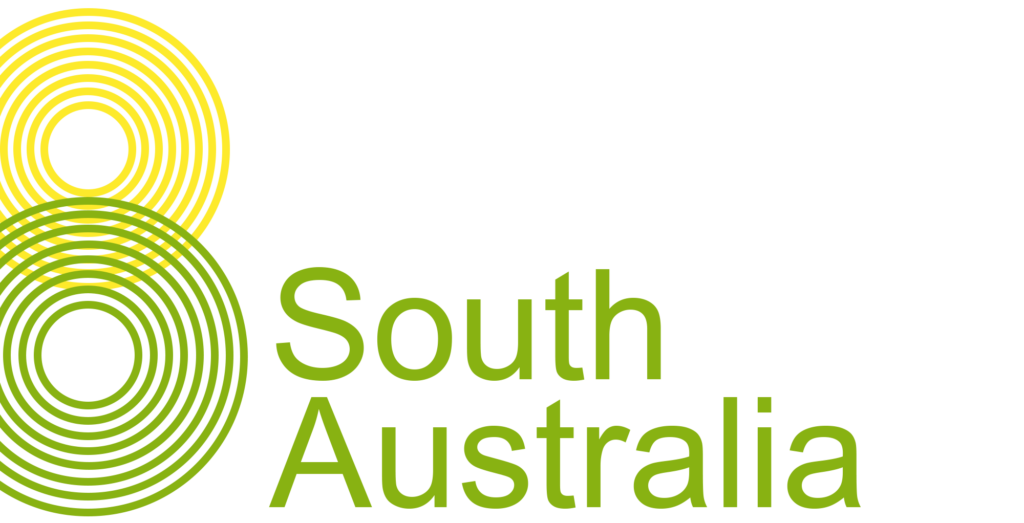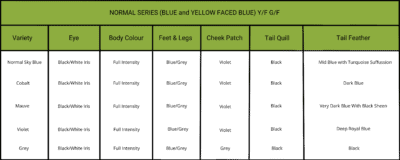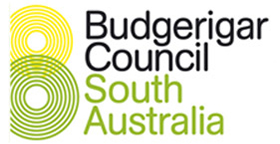
Golden Face Blue Budgerigar (Australian Yellow Face)
The Golden Face Blue Budgerigar, often referred to as the Australian Yellow Face Budgie, is Class #6 at the ANBC National Titles.

Image Courtesy of Rod Turnbull and the ANBC
On account of its heritage, the Golden Face is referred to as Australian Yellow Face (AYF) Budgie. This Yellow Face mutation occurs in single and double factor forms. The double factor mutation is the exhibition standard for this variety. While the variety has been around for many years, it only recently made it into the Exhibition matrix. It is different to the English yellow face, in the intensity of the yellow in the face. It also differs from the English yellow face, in that a Single Factor English Yellow face is the exhibition standard, and a double factor English yellow face appears visually as a non-yellowface, whereas the Golden face Double Factor variety is the Exhibition standard.
Identification of the Australian Golden Faced Blue Budgerigar
The Standard for the Australian Golden Faced Blue budgerigar is as for all varieties in the blue series including grey and conforms in every respect except in the following detail:
The exhibition Australian Golden Faced Blue budgerigar is the double factor form. The body colour is as for the non-yellow faced series colour with minimal intrusion of yellow affecting the purity of the primary colour rump and underparts which are solid and uniform throughout, has a cream/lemon face and forehead. The back and wing coverts (upper & under), are as for the appropriate blue series variety, with clearly defined white outlining and free from any intrusion of body colour or ‘bloom’. The mask is deep and wide (not cleft) extending beyond two large cheek patchs, is deep buttercup yellow extending over the face and crown with minimal intrusion into the undulation at the back of the head. The mask is ornamented by six clearly defined large symmetrical throat spots, the outer spots being partially covered by the base of the violet cheek patches.
Markings on the cheeks, back of head, neck and wings a minimal flush of yellow visible in the otherwise white areas at the edge of the markings. The Australian Golden Faced Blue has a buttercup yellow overlay on the otherwise white areas of the secondary tail feathers, a black eye with white iris ring, and the feet are blue/grey in colour. The cock has a blue cere whilst the hen has a brown cere.

Points to Note with the Australian Golden Face Budgerigar
Breeder can produce Australian Golden Face in both single factor and double factor forms. Only the double factor forms exhibit the prescribed blue or grey color. The single factor forms, when combined with the dark factor, can proportionately conceal the intrusion of yellow. The resulting shades of blue are not penalized as heavily for color, unlike the sky blue form. In the absence of a dark factor, birds in the single factor form typically show yellow suffusion to an extent that leads to a sea green or grey-green body color. Thus, this form of discoloration attracts a disqualification for the exhibition budgerigar as it lacks visual evidence of blue or grey.
In the exhibition budgerigar, breeders can combine Australian Golden face with any variety that displays a white ground color. Minimal spillage of yellow from the mask is acceptable, as described for the normal Golden face blue. To clarify, varieties with reduced melanin are penalized for color in proportion to the extent of departure from minimal. This is relative to the description for the normal Golden face blue. Exhibition judges heavily penalize points for color in self-colored varieties that significantly deviate from minimal spillage of yellow. The single factor forms exhibit a much stronger yellow intrusion, resulting in a corresponding penalty.
Suggested Pairings to Produce Australian Golden Faced Blue Budgerigars
Breeder can produce Australian Golden Face in both single factor and double factor forms. However, only the double factor forms exhibit the prescribed blue or grey color. In the absence of a dark factor, birds in the single factor form typically show yellow suffusion. To this end, the extent leads to a sea green or grey-green body color. This form of discoloration attracts a disqualification as it lacks visual evidence of blue or grey. With this in mind, breeders should pair Golden-faced budgerigars into dark-factored birds to achieve the best results.

Click here for suggested pairings for the Australian Golden Face Blue Budgerigar (Australian Yellow Face Budgie)

- Click here for the Normal Golden Face Blue Budgerigar/Australian Yellow Face Budgie (Double Factor)
- Click here for the Normal Golden Face Blue Budgerigar/Australian Yellow Face Budgie (Single Factor)
- Click here for the Normal Golden Face Blue Budgerigar/Australian Yellow Face Budgie (Double Factor)
- Click here for the Normal Golden Face Blue Budgerigar/Australian Yellow Face Budgie (Single Factor)
